This post contains affiliate links, which means I may earn a commission if you purchase through those links (at no extra cost to you).
I grew up making Orange Marmalade the old-fashioned way: soaking citrus overnight and boiling it rigorously to extract the natural pectin in the rind. When you follow my technique, you don’t need to add any store-bought pectin, and you get the best, cleanest-tasting marmalade.
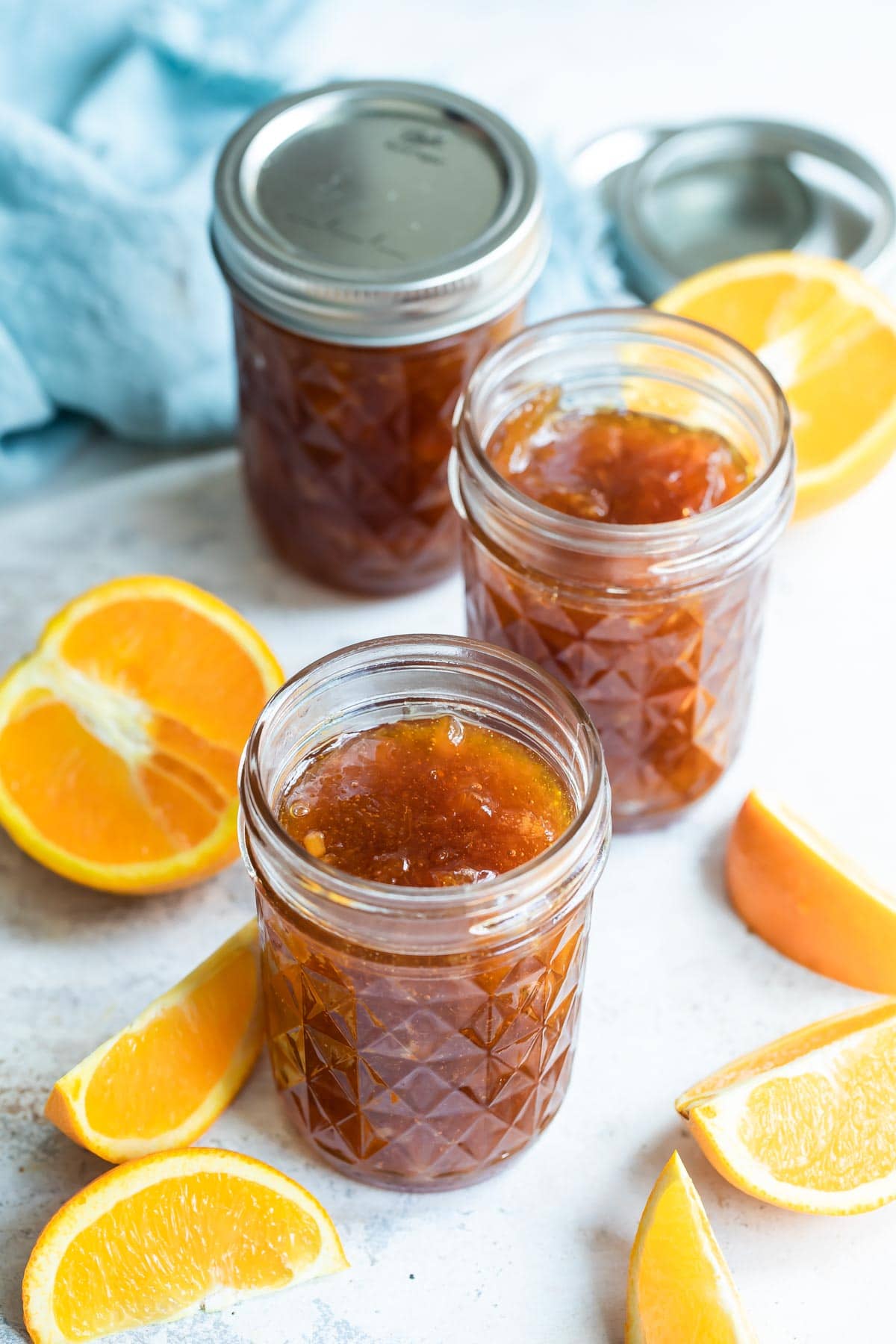
Nearly 1,000 5-star reviews prove this unfussy technique is simple and easy to follow. I also include my handy “cold plate test” so you can know for sure whether your marmalade is done or needs a little bit more time on the stove.
Home cooks everywhere are putting their abundant citrus to use to make their own homemade marmalade, and now you can, too. This recipe makes about 3 quarts total, or 12 (8 ounce jars). It freezes beautifully or you can process it in a water bath for canning.
Table of Contents
Marmalade Ingredients
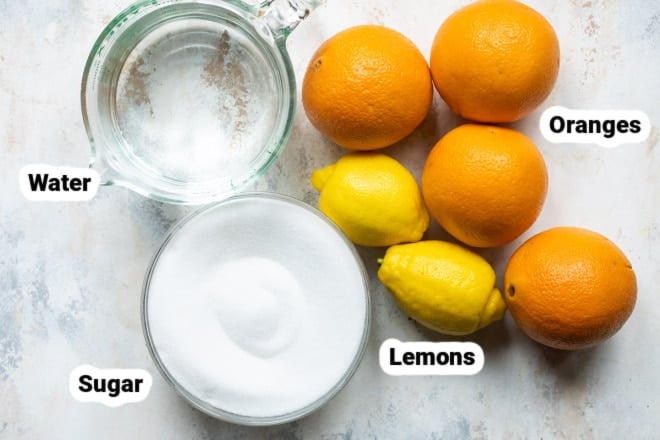
At a Glance: Here is a quick snapshot of what ingredients are in this recipe.
Please see the recipe card below for specific quantities.
- Oranges: This recipe is made with regular seedless oranges. You can definitely substitute Seville oranges if you can find them. They are only in season from the end of January to mid-February, but they have an intense flavor that is ideal for marmalade.
How to make Orange Marmalade
- Using a sharp knife, cut oranges and lemons in half crosswise, then into very thin half-moon slices. Discard any seeds. In a large pot (stainless steel), add the sliced oranges, lemons, and any fruit juice.
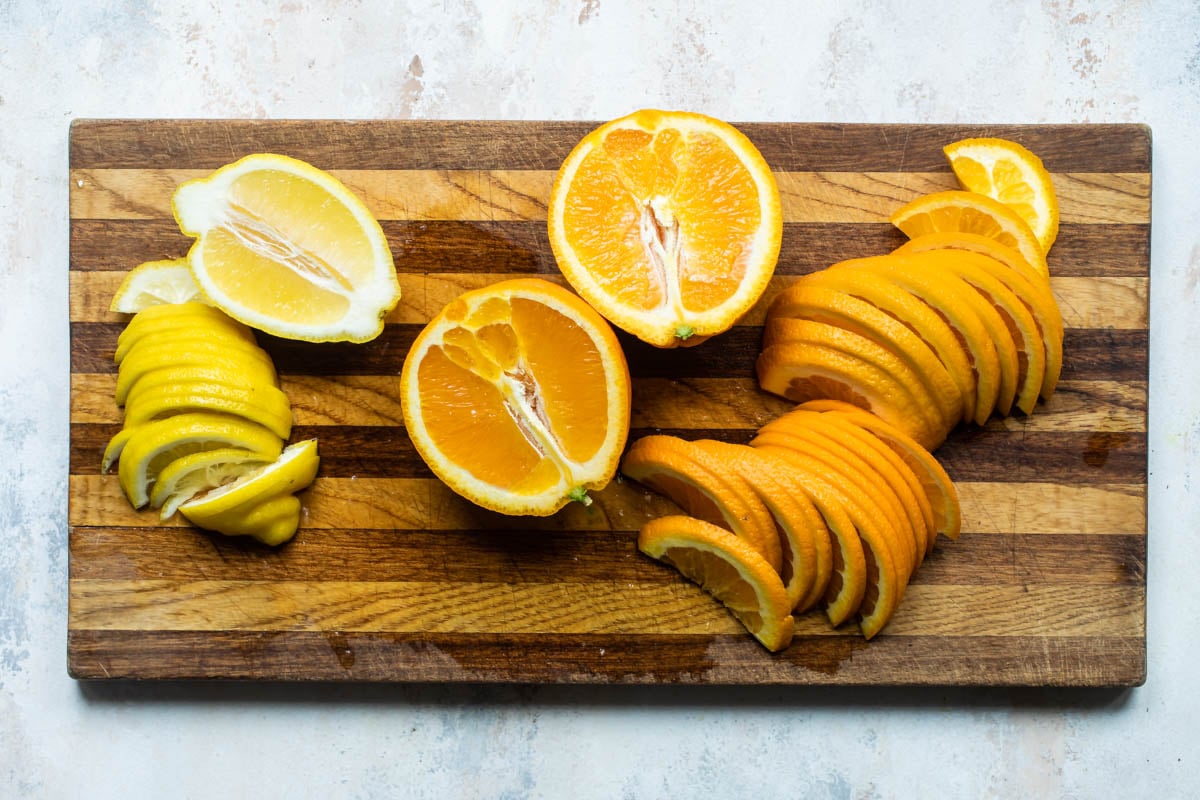
- Add water and bring the mixture to a boil over medium heat, stirring often. Remove from the heat and stir in the sugar until it dissolves. Cover and let stand overnight at room temperature.
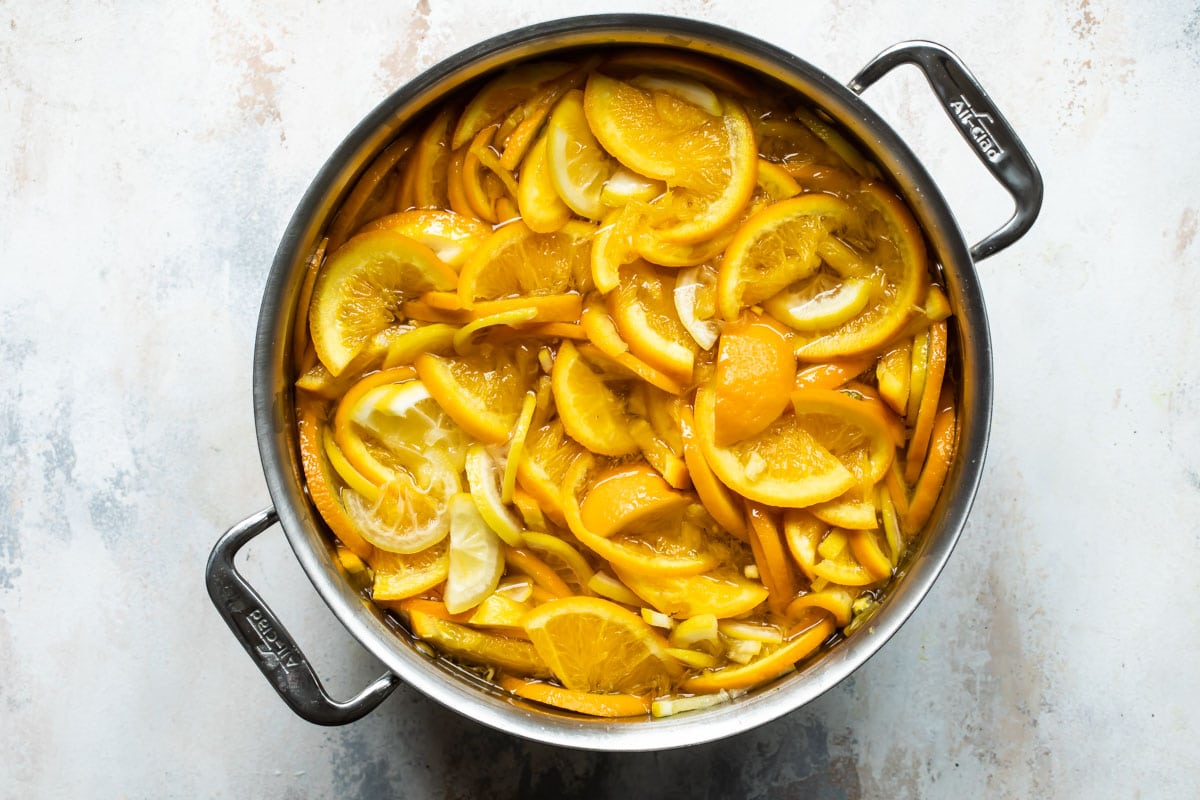
- The next day, bring the mixture back to a boil in the pot or saucepan. Reduce heat to low and simmer uncovered for 2 hours. Turn heat up to medium and boil gently, stirring often, for another 30 minutes. Skim off any foam that forms on the top. Cook until it reaches 220 degrees on a candy thermometer (you must hit this temperature for the natural pectin to gel with the sugar).
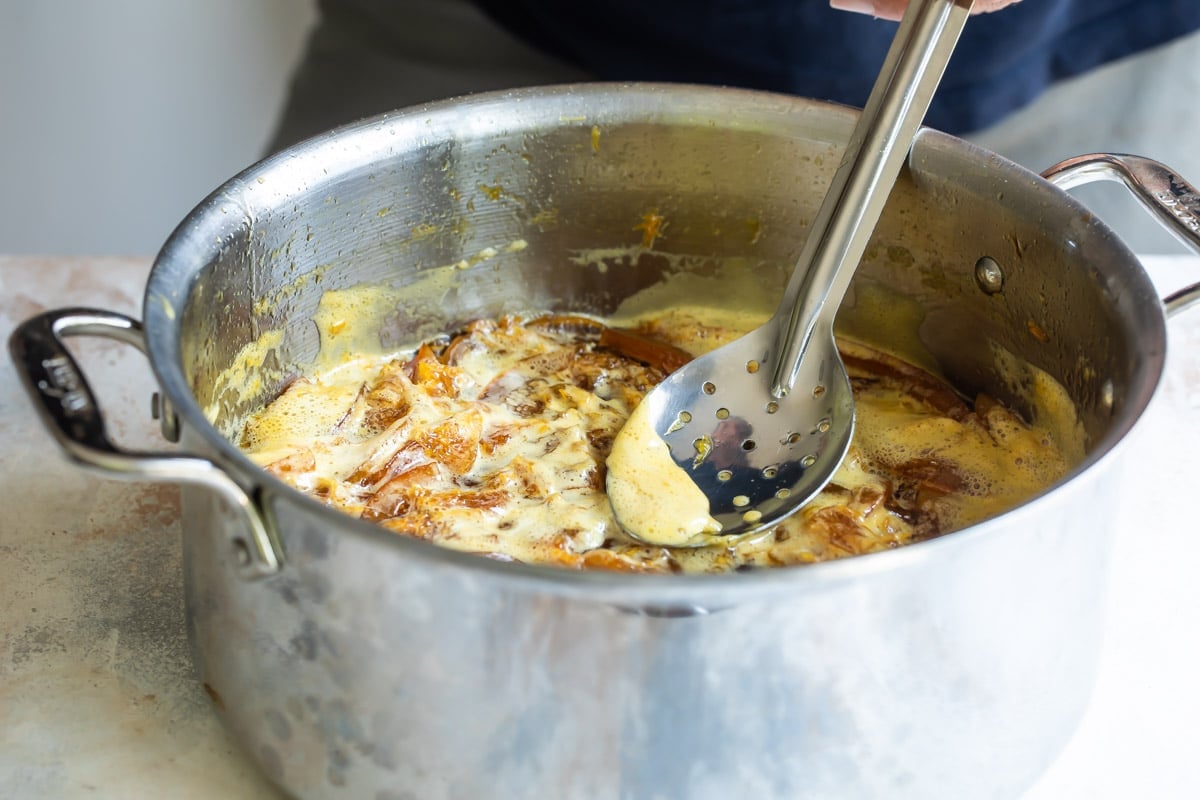
- To test if the marmalade is ready, place a small amount on a plate and refrigerate it until it’s cool but not cold. If it’s firm (neither runny nor hard), it’s ready. It will be a golden orange color. If it’s still runny, continue cooking it; if it’s hard, add a bit more water.
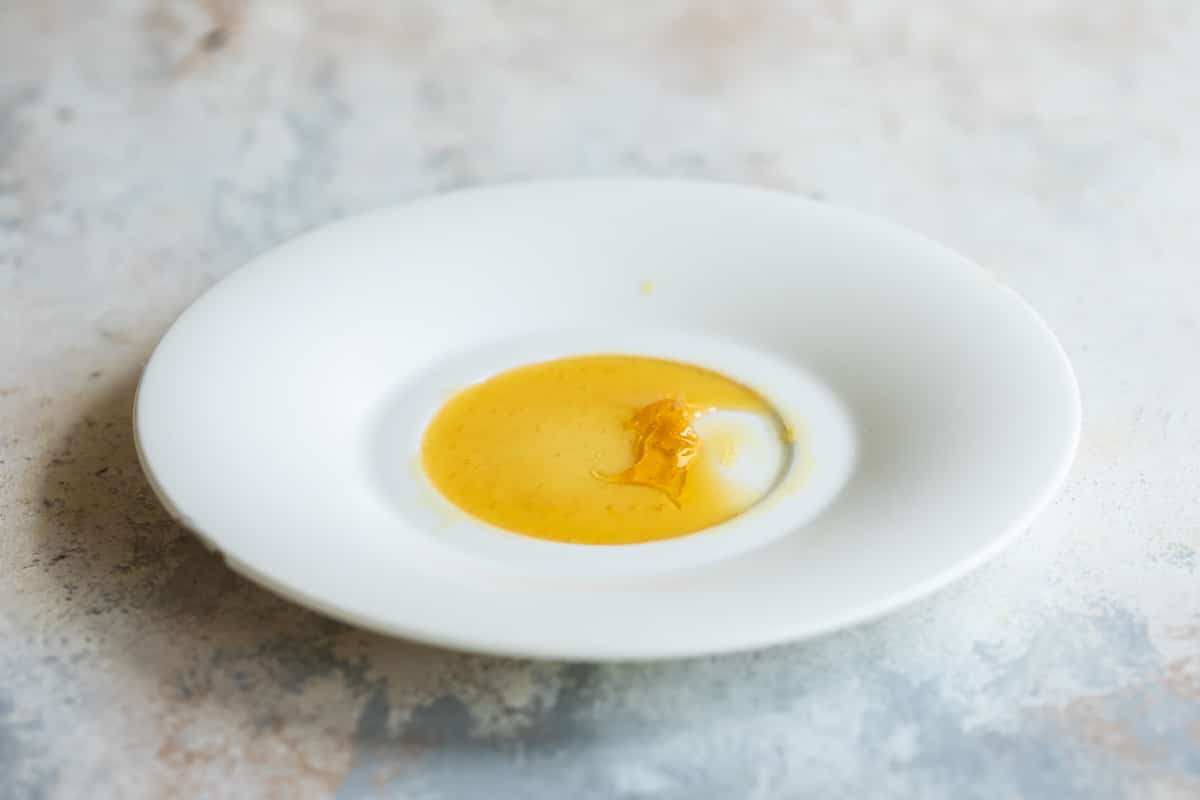
- Pour or ladle the marmalade into clean hot mason jars (I use this wide-mouth jar funnel for this recipe and so many others). Wipe the rims thoroughly with a clean damp paper towel, and seal with the lids. Chill in the refrigerator. It may take 24-48 hours for the natural pectin to set up properly.
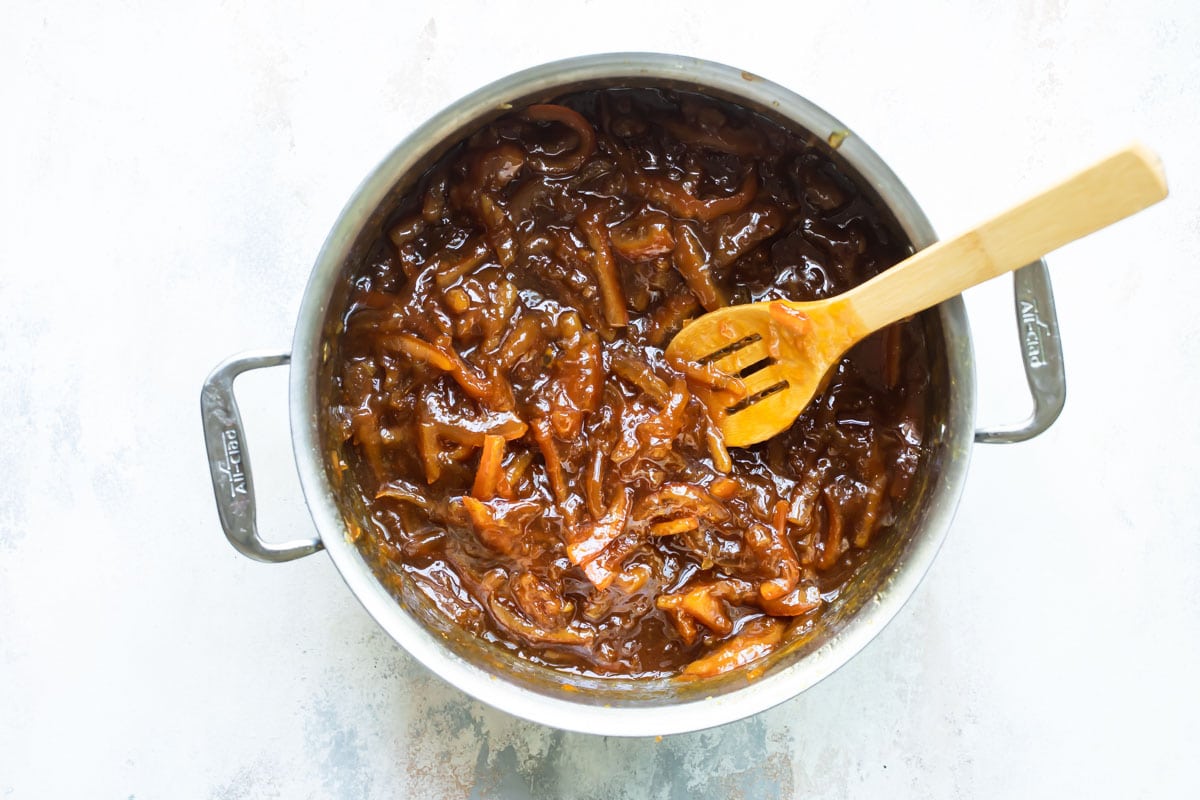
Orange Marmalade Recipe Variations
- Pectin: While many jam and jelly recipes require added pectin, you don’t need to add any here. Pectin is naturally concentrated in the pith of the orange (the bitter white part under the peel). This recipe coaxes out that natural pectin by letting the citrus soak overnight and then boiling it rapidly until enough water has evaporated that the mixture can reach 220 degrees.
- Agave nectar: Agave cannot penetrate and sweeten the peel as well as sugar can. When I tested it, the consistency was fine, but the rind tasted like raw rind. I don’t recommend this substitution.
- Low sugar: I haven’t tested low-sugar/alternative sweeteners in this recipe other than agave as listed above nor have I tweaked the amount of sugar in the recipe. I recommend seeking out recipes from experts in that area.
- Slow cooker: While it is technically possible to make marmalade in your slow cooker, it really depends on the power of your appliance. I no longer recommend that method because it isn’t reliable enough.
- Instant pot: Even with an overnight soak, the IP doesn’t break down the rind sufficiently. I don’t recommend this method.
Marmalade Recipe Tips
- Yield: This recipe makes about 3 quarts (96 ounces) of marmalade.
- If using 1/2-pint (8 ounce) jars, you’ll need 12.
- If using 1 pint (16 ounce) jars, you’ll need 6.
- If using the tiny jelly jars (4 ounce), you’ll need 24.
- Cold-plate test: To test if your marmalade is ready, spoon some hot marmalade on to a small plate and put it in the freezer to chill, or spoon some over an icy cold plate fresh from the freezer. If the mixture wrinkles slightly when you draw a spoon or finger across it, it has reached the setting point and is ready to go! If not, keep boiling and make sure the temperature reaches 220 degrees.
- Set-up time: Orange marmalade takes 24-48 hours for the natural pectin to set up completely. If it’s is still a little runny looking when it cools, check again in a day or two.
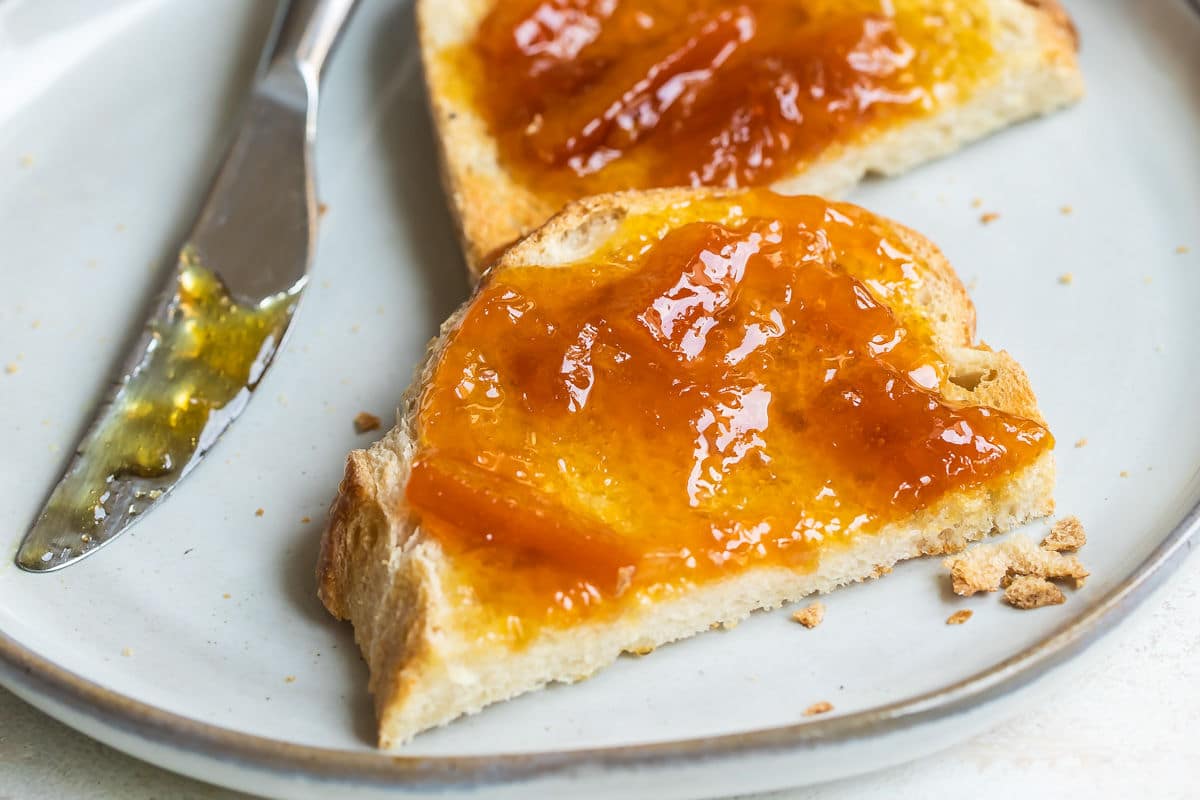
Storing and Canning Orange Marmalade
Storage: Store covered in the refrigerator for up to 1 month.
Freezer: Pack in freezer-safe containers or jars leaving 1/2-inch of headspace for expansion. Label, date, and freeze for up to 3 months. Thaw overnight in the refrigerator.
Canning: If putting up for storage, use a hot water or steam canner with a rack to properly seal lids on canning jars according to canning instructions. Otherwise, refrigerate and use within the month. Or, freeze for up to 3 months.
Frequently Asked Questions
Pectin is naturally concentrated in the pith of the orange (the bitter white part under the peel), so you don’t need to add any here. This recipe coaxes out that natural pectin by letting the citrus soak overnight and then boiling it rapidly until enough water has evaporated that the mixture can reach 220 degrees.
While it is technically possible to make marmalade in your slow cooker, it really depends on the power of your appliance. I no longer recommend that method because it isn’t reliable enough.
Even with an overnight soak, the IP doesn’t break down the rind sufficiently. I don’t recommend this method.
Agave cannot penetrate and sweeten the peel as well as sugar can. When I tested it, the consistency was fine, but the rind tasted like raw rind. I don’t recommend this substitution.
I don’t recommend making this recipe in a regular cast iron pan. It should be made in a non-reactive pan. Enameled cast iron, stainless steel, and non-stick are best and will not affect the color or taste of the marmalade
More fruit recipes
Pie and Tart Recipes
Fresh Fruit Tart
Fruit Dessert Recipes
Apple Crisp with Oatmeal
Cake Recipes
Lemon Bundt Cake Recipe
Muffins and Quick Breads
Banana Muffins
Join Us

Orange Marmalade
Equipment
- Jar funnel (for wide mouth jars)
Ingredients
- 4 large seedless oranges scrubbed clean (about 3 pounds or 8 cups slices, see note 1)
- 2 lemons (about ½ pound or 1 cup slices)
- 8 cups water
- 8 cups granulated sugar
Instructions
- Cut oranges and lemons in half crosswise, then into very thin half-moon slices. Discard any seeds. In a large stainless steel pot, add the sliced oranges, lemons, and any accumulated juices.
- Add water and bring the mixture to a boil, stirring often. Remove from the heat and stir in the sugar until it dissolves. Cover and let stand overnight at room temperature.
- The next day, bring the mixture back to a boil. Reduce heat to low and simmer uncovered for 2 hours. Turn heat up to medium and boil gently, stirring often, for another 30 minutes.
- Skim off any foam that forms on the top. Cook the marmalade until it reaches 220 degrees (you must hit this temperature for the natural pectin to gel with the sugar).
- To test if the marmalade is ready, place a small amount on a plate and refrigerate it until it's cool but not cold (see note 4). If it's firm (neither runny nor hard), it's ready. It will be a golden orange color. If the marmalade is runny, continue cooking it; if it's hard, add a bit more water.
- Pour the marmalade into clean hot mason jars; wipe the rims thoroughly with a clean damp paper towel, and seal with the lids. Chill in the refrigerator. It may take 24-48 hours for the natural pectin to set up properly.
Recipe Video
Notes
- Oranges: This recipe is made with regular seedless oranges. You can definitely substitute Seville oranges if you can find them. They are only in season from the end of January to mid-February, but they have an intense flavor that is ideal for marmalade.
- Yield: This recipe makes about 3 quarts (96 ounces) of marmalade.
- If using 1/2-pint (8 ounce) jars, you’ll need 12.
- If using 1 pint (16 ounce) jars, you’ll need 6.
- If using the tiny jelly jars (4 ounce), you’ll need 24.
- Storage: Store covered in the refrigerator for up to 1 month.
- Cold-plate test: To test if your marmalade is ready, spoon some hot marmalade on to a plate and put it in the freezer to chill, or spoon some over an icy cold plate fresh from the freezer. If the mixture wrinkles slightly when you draw a spoon or finger across it, it has reached the setting point and is ready to go! If not, keep boiling and make sure the temperature reaches 220 degrees.




This marmalade looks so delicious, but I don’t see the ingredient amounts listed. Please help. Thank you.
Hi Lucy, here they are:
4 large seedless oranges scrubbed clean (about 3 pounds or 8 cups slices, see note 1)
2 lemons (about ½ pound or 1 cup slices)
8 cups water
8 cups granulated sugar
You can find them and the full directions in the recipe box that is above the comment section in the post, or by clicking the “Jump to Recipe” button at the top. Take care! – Meggan
I’ve made this a couple of times using Calamansi and it’s really delicious. Thank you
Hi Qu, you’re so welcome! Happy you love it! Take care! – Meggan
WOW! is all I can say! Not only is it easy to make, it is the best orange marmalade I have ever tasted. gave a jar
to my neighbor, who called to say it is the best she has ever tasted. Thank you for sharing the recipe.
Hi Linda, so happy you loved it and shared it with a neighbor! You’re so welcome! Take care! – Meggan
I have a large crop of sour oranges that I’d like to make into marmalade. Should I leave out the lemon and increase the amount of oranges since the oranges themselves are tart?
Hi Stephanie, you can, but I would likely leave them in because they provide acidity and pectin to help the marmalade set. Take care! – Meggan
Super easy and delicious. A great way to use up some citrus you have in the fridge.
Thank you so much for the comment, Donna! – Meggan
I have lemon peels that have been sprinkled with sugar to remove the oils for oleo-saccharum. I’d like to use the peels, which still have some decent flavor to them. Can I make marmalade from the leftover peels, and should the recipe be modified? Do you think it would need extra pectin added? If you don’t think marmalade would work, any suggestions on how to use them?
Hi Sparkles, you might be able to, but you’ll still need the pith of the lemons for the pectin. If not, additional pectin would likely be needed. I haven’t tried it myself, so I can’t say for sure, and wouldn’t want you to waste beautiful produce. My first thought would be to try to make limoncello out of them, crystalize them and use them as a topping on a lemon cake or chop them to top muffins. Hope this helps! Take care! – Meggan
An excellent recipe! I make a traditional British orange marmalade, using Seville oranges for myself and this one for my wife. Really great flavor, easy to do. Yes, it is time consuming but very little hands-on time required. I do use an immersion blender at the end to lightly chop up some of the orange rinds. Also throw in some Patron Citronge Orange Liqueur. Use boiling water method to can this and then enjoy it for about 16 months. Many thanks, Ms. Hill
You’re so welcome, Luther! Thank you so much for your comment. I love the addition of orange liquor and using the immersion blender at the end. Take care! – Meggan
My third year making this delicious marmalade. It’s perfect every time! Thank you 😊
You’re so welcome, Alison! I appreciate you coming back and making it year after year! Take care! – Meggan
Omg…. I changed this up a bit I added some Rainer cherries that were getting old, added 2 cups tart cherry juice and 6 cups water after the pot got cold on the overnight I added 1/2 brandy with some vanilla bean. Did the cook the same way as the recipe and it came out amazing!!! Great base recipe the overnight worked wonders I did tie the pot lid on to reserve the heat for as long as possible. Thankyou so much!
Hi there! I love this! Sounds absolutely delicious! – Meggan
Megan it came out GREAT! Thankyou for this well put together recipe!!!! Could not have done this one without you. So very grateful for your help.
So delicious, beautiful and worth the time and effort. I will be making this again. I’m new to jams and jelly and was worried about this working out. But it was incredibly easy. Thanks for a great recipe!
You’re so welcome, Tiffany! I’m so happy you loved it, and loved making it! Take care! – Meggan